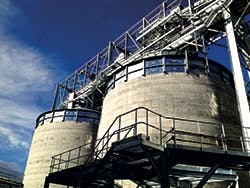Rembe Flameless Venting System Protects Against Combustible Dust
Rembe develops a new safety approach for protecting coal/wood grinding plants against the ravages of a combustible dust explosion using flameless venting devices and leak-tight explosion venting panels.
Roller mills are usually located inside buildings. Conventional venting concepts are based on free and open venting devices, such as explosion panels, which force operators, architects and engineers to consider enough space, proper location and sufficient ducting to vent to the outside. With the advent of indoor/outdoor flameless venting technology by Rembe, indoor venting is available and changes to the building (breaking through an exterior wall or roof) or plant floor (relocating mills so they are closer to exterior walls) are reportedly no longer required. Because flameless explosion venting devices can be mounted inside the building, the explosion venting occurs at the commencement of an explosion and in much closer proximity to the starting point of the explosion. Thus, an explosion is instantly vented and will be less severe in comparison to conventional venting.
With Rembe flameless venting devices, in the event of an explosion, in most cases, downtime can be minimized. Users can simply replace the rupture disc, inspect and clean the venting device and it is ready to be used again. To protect the downstream bag filter against excessive pressure in the event of an explosion, appropriate venting must be applied. Complete explosion protection also requires inlet isolation to avoid flame propagation. Should an event occur, an explosion panel opening can be detected by a signaling unit. The signaling device, with its ultra-low current, is intrinsically safe and operates on a simple, open-closed principle. The quantity and size of explosion panels depends on the bag filter inlet size, the volume and the pressure resistance.
Due to the low vacuum conditions present in the fine coal/wood bin, single-layer vent panels with signaling units are the preferred explosion protection opton. For the bag filter, the quantity and size of explosion panels depend on the volume to be vented and the pressure resistance. For bins installed inside, the application of an indoor flameless venting system with flame absorber is the right approach, according to Rembe. The quantity and size of flameless venting systems depends on the volume to be vented and the pressure resistance. This passive system safety concept eliminates both the risk of false triggers and the required regularly scheduled maintenance by external professionals that are typical of active systems.
